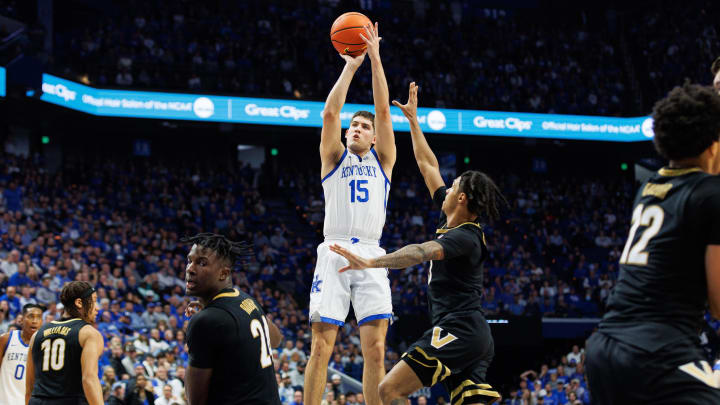2024 NBA Draft: Reed Sheppard Scouting Report

Reed Sheppard had a statistically historical season this past year. To start, the Kentucky guard was one of three players to qualify for my Productive Young Athlete query -- a statistical query with a 78% "stick" rate that focuses on productive freshmen.
Additionally, Sheppard finished with the 15th-highest Box Plus-Minus for a freshmen since it began being tracked on Barttorvik.com in 2008. He averaged 12.5 points, 4.5 assists, 4.1 rebounds, 2.5 steals, and 0.7 blocks per game in 28.9 minutes per game. The incredible part was his efficiency: 65% at the rim (60 attempts), 45.8% on non-rim twos (59 attempts), an astounding 52% from beyond the arc (144 attempts), and 83% from the free throw line (65 attempts). Sheppard was also unassisted on 54.6% of his made field goals this season (90.9% of his made field goals inside the arc are unassisted) while recording a 24.1 assist percentage and making a significant defensive impact as an event creator with a 4.6 steal percentage and 2.5 block percentage.
Key Information
Year: Freshman
Birthday: 6/24/04 (20.0 years old at the time of the NBA Draft)
Physical: 6-foot-3, 182 pounds, 6-foot-3 wingspan
Physical Comparison: Stephen Curry (6-foot-3, 181 pounds, and 6-foot-3.5 wingspan at the 2009 NBA Combine)
Introduction
Reed Sheppard has the potential to fulfill a secondary ball-handler role in the NBA, as his off-ball shooting complements his secondary playmaking ability. He's an elite shooter -- both in catch-and-shoot and off the dribble situations -- and a sound decision-maker out of the pick-and-roll. The pick-and-roll is also an area in which his off the dribble shooting can be effective. Sheppard is a solid finisher at the rim (65% for the season on 60 attempts), but isn't a dynamic rim threat out of the pick-and-roll nor on self-created drives. However, his feel, shooting ability, and playmaking will allow him to provide value in this secondary ball-handler role. Defensively, Sheppard can improve his ability to contain drivers. At 6-foot-3 with a 6-foot-3 wingspan, he's slightly undersized in the "two" spot as a secondary ball-handler. However, he creates some defensive value with his elite hands, which impact the game by generating steals on-ball defensively, reading passing lanes for off-ball steals, and contesting shots at an elite level.
Offense: Secondary Ball-Handler
Catch-and-Shoot Threes
One of the most important baseline skills to seeing the floor in the NBA today is the ability to hit catch-and-shoot threes. Luckily for Sheppard, this is his most translatable NBA skill. As mentioned earlier, Sheppard shot an incredible 52% from beyond the arc (144 attempts) this past season and 83% from the free throw line (65 attempts).
Potential Shooting Versatility
Sheppard is not a simple scout, hence why some scouts view him as one of the top players in the draft while others have him late lottery. Much of the dichotomy regarding his draft stock is likely directly correlated with how much a scout believes in his shooting versatility. If an evaluator sees his shooting potential as untapped with the chance to be an off screen shooter and eventually a movement shooter, then this evaluator may have him closer to a top pick in the draft. An alternative evaluator and, one that I would consider myself closer aligned with, may think he has potential as an off screen shooter (in which he was rarely utilized at Kentucky) but likely will not develop into a movement shooter. However, his lack of size makes fulfilling this archetype more difficult than a player like Antonio Reeves, for example.
Below are examples of versatile shooting from Reed Sheppard, including examples of dribble jumpers, an off-screen three, and a self-created stepback three. For context, Sheppard converted 52.1% of his dribble jumpers this past season (73 attempts, 99th Points Per Shot percentile).
Attacking Closeouts
Sheppard has also shown potential attacking closeouts, which could help him fulfill more of a dribble-pass-shoot archetype if needed and assists in him providing value as a secondary ball-handler as well. He makes himself a threat to shoot, leading the defense further out and helping to force a defensive rotation.
Slashing
While it's unlikely that Sheppard will be able to consistently create rim pressure without a screen at the next level, the change of pace he utilizes in the pick-and-roll (which will be discussed later) helps him generate rim pressure at times as well. However, the clip at the end illustrates what can also show up on film as well -- an inability to get to the rim without a screen at times. Sheppard recording only 60 attempts at the rim this past season also speaks to this latter point.
Pick-and-Roll Midrange Scoring & Playmaking
Both the ability to hit catch-and-shoot threes at an elite rate and attack closeouts will allow Sheppard to provide baseline value in an off-ball guard role. An area of his game that could take him to the next level and allow him to fulfill more of a secondary ball-handler role is his potential in the pick-and-roll, both as a midrange scorer and playmaker. Sheppard uses a compact, tight dribble and savvy change of pace at times to create a pull-up for himself or an open look for others.
Defense
Reed Sheppard may face an uphill battle defensively in the NBA due to his 6-foot-3 height and slightly longer than 6-foot-3 wingspan. The main questions then become: Does he hold his own on that end of the floor despite his lack of size? Will he be targeted for mismatches in the NBA? How much value does he provide in other ways defensively?
Defense: Areas of Improvement
While Reed Sheppard has shown flashes of lateral quickness, he gives up too many driving angles. Even if this was partially scheme-based, both Sheppard's technique on-ball and lateral quickness must improve if he wishes to not be targeted in the NBA. Additionally, his lack of relative strength can lead to him fighting for defensive position.
Defense: Strengths
Despite giving up too many driving lanes and being undersized by NBA standards, Sheppard adds value on the defensive end in a unique way: his hand-eye coordination allows for him to generate a multitude of steals and blocks. Whether it's his excellent hands on-ball, genius positioning in passing lanes, or a calculated contest deterring a shot, Sheppard provides value defensively to counteract his lack of on-ball defensive prowess.
Conclusion
Reed Sheppard is an interesting and intriguing NBA prospect. While he has clear NBA-ready skills in many areas, his potential is full of question marks -- leading to a wide range of opinions about him. Offensively, while he was efficient in the pick-and-roll last season and has shown solid feel and playmaking ability, he projects more as a secondary playmaker. This will also allow him to play more of an off-ball shooting role rather than being tasked with creating rim pressure and offense without screens -- an area that may be difficult for him to have an impact in at the NBA level. His shooting ability is elite, but whether he can develop into a movement or even an off-screen shooter has yet to be truly seen. Defensively, a 6-foot-3 secondary ball-handler would be slightly undersized, especially if he has to play with another primary ball-handler (likely another guard with a similar size). Additionally, while he generates a tremendous amount of steals and blocks for a guard, he also gives up driving lanes too often. For a prospect with this many outcomes, this is a time in which his qualifying for the Productive Young Athlete query may be weighted more than usual -- with analytics indicating a high likelihood (78% chance) of him sticking in the NBA.
Possible Low Outcome
Offensively, Sheppard's lack of ability to be a true rim threat out of both the pick-and-roll and without a screen makes him less dynamic as a ball-handler, leading to difficulties impacting the game offensively. While his catch-and-shoot threes remain a floor for him, he never develops into a movement or off-screen shooter, as his lack of size and form may not adhere to fulfilling these potential archetypes. Defensively, while his event creation still translates, his lack of size and lateral quickness lead to him being targeted on mismatches consistently when on the floor. This, combined with his lack of on-ball juice, leads to him not providing significant value for the team that drafts him.
Possible High Outcome
Sheppard's elite catch-and-shoot ability and pick-and-roll efficiency allow him to fit into a secondary ball-handler role within a season or two. His reliable midrange jumper helps him become more dynamic in the pick-and-roll, and his change of pace opens up his ability to get to the rim as well. Defensively, he continues to improve his lateral quickness and strength to the point where he's not being targeted when on the floor. This, combined with his off-ball event creation, leads to him being a slight positive on the defensive end of the floor. As he begins to see the floor more often, his offensive game continues to open up. Sets are drawn up for him to shoot off of screens and his playmaking and change of pace become increasingly effective as his career continues. Lastly, his best-case scenario is that his shooting ability was far from just being applicable on catch-and-shoot or off-screen threes, but that Sheppard had untapped potential as a movement shooter. This leads to him providing immense value on the offensive end.
Grade: Picks 16-20
All play-by-play data is courtesy of Synergy Sports.
Want to join the discussion? Like Draft Digest on Facebook and follow us on Twitter to stay up to date on all the latest NBA Draft news. You can also meet the team behind the coverage.
